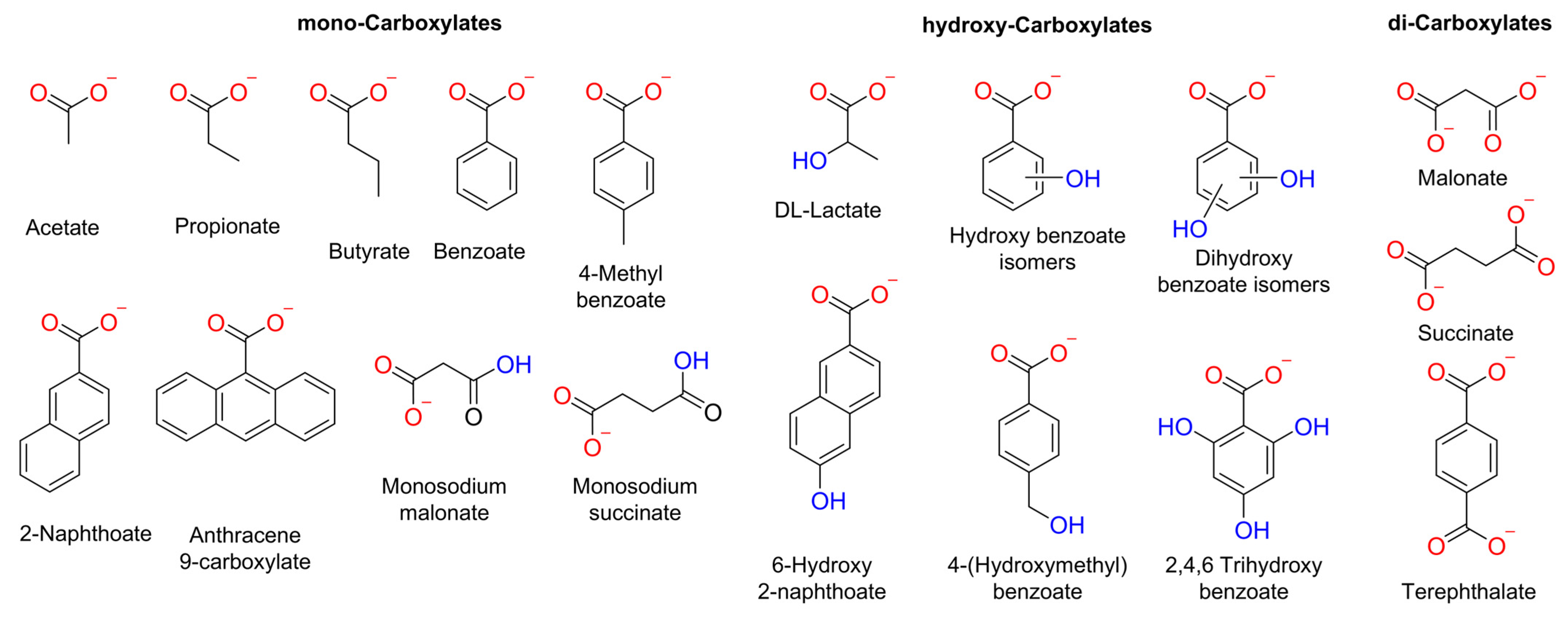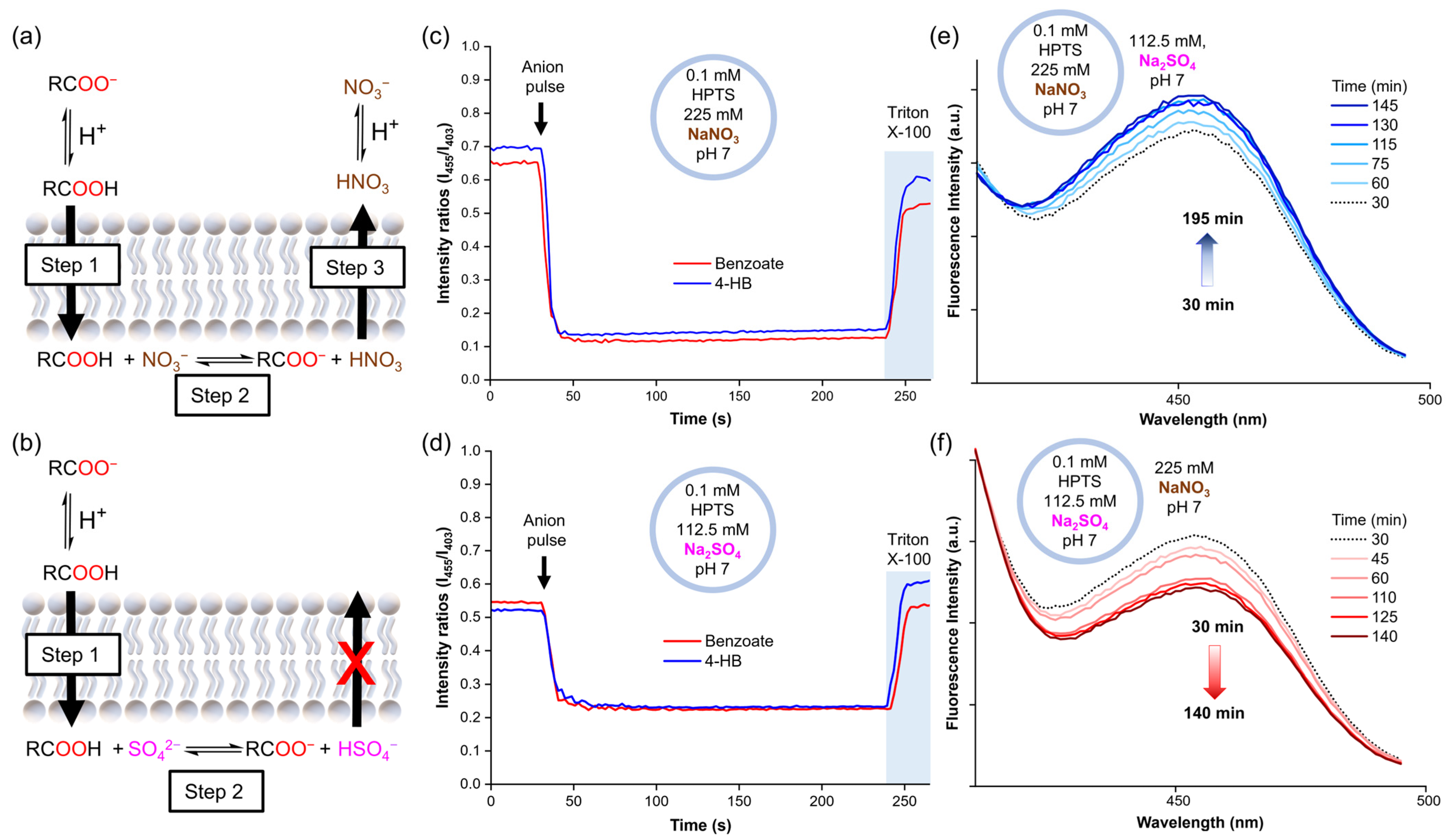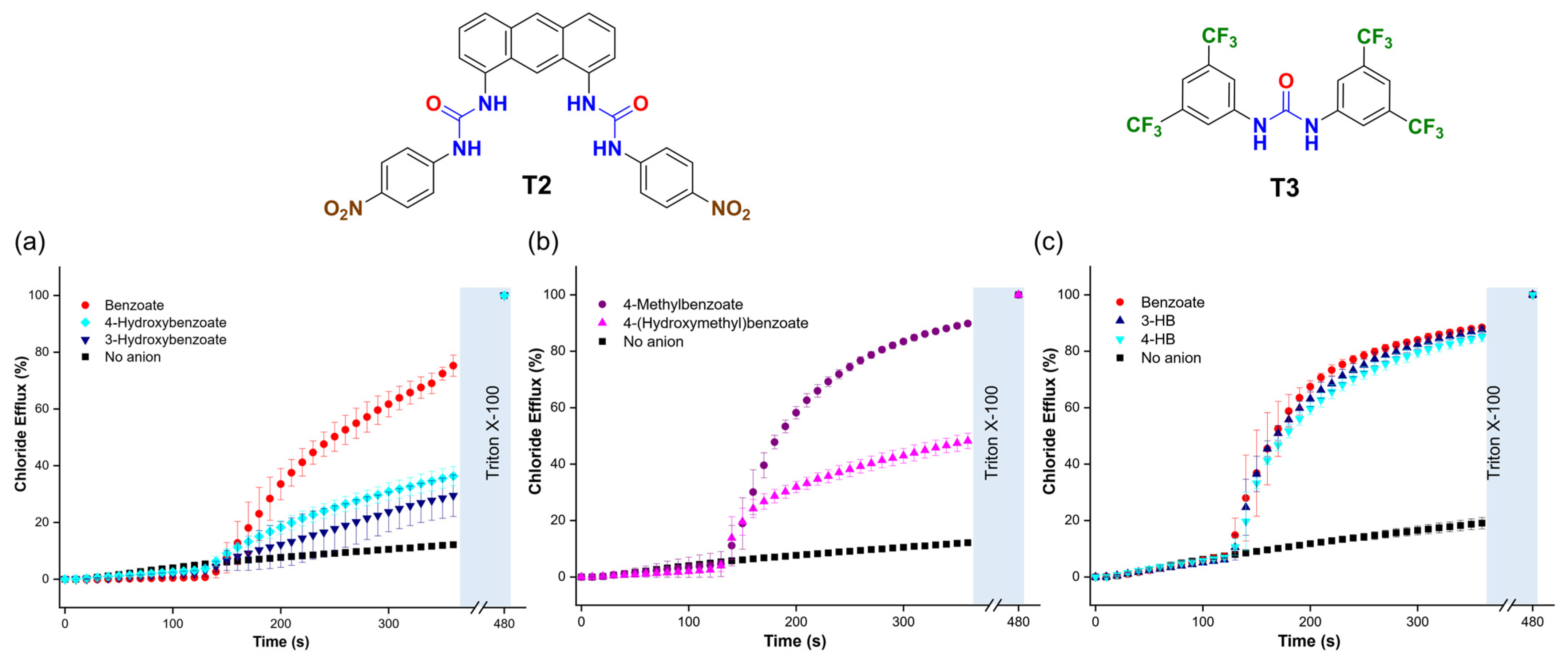The Role of the Organic Moiety in the Diffusion and Transport of Carboxylates into Liposomes
Abstract
:1. Introduction
2. Results
2.1. Fluorescence Studies to Monitor the Spontaneous Diffusion of Carboxylates
2.2. Mechanism of Carboxylate Diffusion
2.3. The Role of the Organic Moiety in the Diffusion of Carboxylates
2.4. Assisted Transport of Carboxylates
2.5. Effect of Hydroxyl Groups on the Assisted Transport of Carboxylates
3. Materials and Methods
4. Conclusions
Supplementary Materials
Author Contributions
Funding
Institutional Review Board Statement
Informed Consent Statement
Data Availability Statement
Acknowledgments
Conflicts of Interest
References
- Davis, J.T.P.; Gale, A.; Quesada, R. Advances in Anion Transport and Supramolecular Medicinal Chemistry. Chem. Soc. Rev. 2020, 49, 6056–6086. [Google Scholar] [CrossRef] [PubMed]
- Yang, J.; Yu, G.; Sessler, J.L.; Shin, I.; Gale, P.A.; Huang, F. Artificial Transmembrane Ion Transporters as Potential Therapeutics. Chem 2021, 7, 3256–3291. [Google Scholar] [CrossRef]
- Nigam, S.K.; Bush, K.T.; Martovetsky, G.; Ahn, S.Y.; Liu, H.C.; Richard, E.; Bhatnagar, V.; Wu, W. The Organic Anion Transporter (OAT) Family: A Systems Biology Perspective. Physiol. Rev. 2015, 95, 83–123. [Google Scholar] [CrossRef] [PubMed]
- Skonberg, C.; Olsen, J.; Grimstrup Madsen, K.; Hansen, S.H.; Grillo, M.P. Metabolic Activation of Carboxylic Acids. Expert Opin. Drug Metab. Toxicol. 2008, 4, 425–438. [Google Scholar] [CrossRef]
- Halestrap, A.P. The Monocarboxylate Transporter Family-Structure and Functional Characterization. IUBMB Life 2012, 64, 1–9. [Google Scholar] [CrossRef]
- Lamberth, C.; Dinges, J. Different Roles of Carboxylic Functions in Pharmaceuticals and Agrochemicals. In Bioactive Carboxylic Compound Classes; Wiley: Hoboken, NJ, USA, 2016. [Google Scholar] [CrossRef]
- Zhu, W.; Zhang, Y.; Sinko, W.; Hensler, M.E.; Olson, J.; Molohon, K.J.; Lindert, S.; Cao, R.; Li, K.; Wang, K.; et al. Antibacterial Drug Leads Targeting Isoprenoid Biosynthesis. Proc. Natl. Acad. Sci. USA 2013, 110, 123–128. [Google Scholar] [CrossRef]
- Morgunov, I.G.; Kamzolova, S.V.; Dedyukhina, E.G.; Chistyakova, T.I.; Lunina, J.N.; Mironov, A.A.; Stepanova, N.N.; Shemshura, O.N.; Vainshtein, M.B. Application of Organic Acids for Plant Protection against Phytopathogens. Appl. Microbiol. Biotechnol. 2017, 101, 921–932. [Google Scholar] [CrossRef]
- Moore, S.J.; Haynes, C.J.E.; González, J.; Sutton, J.L.; Brooks, S.J.; Light, M.E.; Herniman, J.; Langley, G.J.; Soto-Cerrato, V.; Pérez-Tomás, R. Chloride, Carboxylate and Carbonate Transport by Ortho-Phenylenediamine- Based Bisureas. Chem. Sci. 2013, 4, 103–117. [Google Scholar] [CrossRef]
- Haynes, C.J.E.; Berry, S.N.; Garric, J.; Herniman, J.; Hiscock, J.R.; Kirby, I.L.; Light, M.E.; Perkes, G.; Gale, P.A. Small Neutral Molecular Carriers for Selective Carboxylate Transport. Chem. Commun. 2013, 49, 246–248. [Google Scholar] [CrossRef]
- Cossu, C.; Fiore, M.; Baroni, D.; Capurro, V.; Caci, E.; Garcia-Valverde, M.; Quesada, R.; Moran, O. Anion-Transport Mechanism of a Triazole-Bearing Derivative of Prodigiosine: A Candidate for Cystic Fibrosis Therapy. Front. Pharmacol. 2018, 9, 852. [Google Scholar] [CrossRef]
- Bak, K.M.; van Kolck, B.; Maslowska-Jarzyna, K.; Papadopoulou, P.; Kros, A.; Chmielewski, M.J. Oxyanion Transport across Lipid Bilayers: Direct Measurements in Large and Giant Unilamellar Vesicles. Chem. Commun. 2020, 56, 4910–4913. [Google Scholar] [CrossRef] [PubMed]
- Salam, R.; Chowdhury, S.M.; Marshall, S.R.; Gneid, H.; Busschaert, N. Increasing Membrane Permeability of Carboxylic Acid-Containing Drugs Using Synthetic Transmembrane Anion Transporters. Chem. Commun. 2021, 57, 13122–13125. [Google Scholar] [CrossRef] [PubMed]
- Alonso-Carrillo, D.; Arias-Betancur, A.; Carreira-Barral, I.; Fontova, P.; Soto-Cerrato, V.; García-Valverde, M.; Pérez-Tomás, R.; Quesada, R. Small Molecule Anion Carriers Facilitate Lactate Transport in Model Liposomes and Cells. iScience 2023, 26, 107898. [Google Scholar] [CrossRef]
- Arias-Betancur, A.; Fontova, P.; Alonso-Carrillo, D.; Carreira-Barral, I.; Duis, J.; García-Valverde, M.; Soto-Cerrato, V.; Quesada, R.; Pérez-Tomás, R. Deregulation of Lactate Permeability Using a Small-Molecule Transporter (Lactrans-1) Disturbs Intracellular PH and Triggers Cancer Cell Death. Biochem. Pharmacol. 2024, 229, 116469. [Google Scholar] [CrossRef]
- Wu, X.; Gale, P.A. Small-Molecule Uncoupling Protein Mimics: Synthetic Anion Receptors as Fatty Acid-Activated Proton Transporters. J. Am. Chem. Soc. 2016, 138, 16508–16514. [Google Scholar] [CrossRef]
- Martínez-Crespo, L.; Sun-Wang, J.L.; Sierra, A.F.; Aragay, G.; Errasti-Murugarren, E.; Bartoccioni, P.; Palacín, M.; Ballester, P. Facilitated Diffusion of Proline across Membranes of Liposomes and Living Cells by a Calix[4]Pyrrole Cavitand. Chem 2020, 6, 3054–3070. [Google Scholar] [CrossRef]
- Maslowska-Jarzyna, K.; Bąk, K.M.; Zawada, B.; Chmielewski, M.J. pH-Dependent Transport of Amino Acids across Lipid Bilayers by Simple Monotopic Anion Carriers. Chem. Sci. 2022, 13, 12374–12381. [Google Scholar] [CrossRef]
- Vargas Jentzsch, A.; Emery, D.; Mareda, J.; Nayak, S.K.; Metrangolo, P.; Resnati, G.; Sakai, N.; Matile, S. Transmembrane Anion Transport Mediated by Halogen-Bond Donors. Nat. Commun. 2012, 3, 905. [Google Scholar] [CrossRef]
- Benz, S.; Macchione, M.; Verolet, Q.; Mareda, J.; Sakai, N.; Matile, S. Anion Transport with Chalcogen Bonds. J. Am. Chem. Soc. 2016, 138, 9093–9096. [Google Scholar] [CrossRef]
- Shinde, S.V.; Talukdar, P. Transmembrane H+/Cl− Cotransport Activity of Bis(Amido)Imidazole Receptors. Org. Biomol. Chem. 2019, 17, 4483–4490. [Google Scholar] [CrossRef]
- Valkenier, H.; Akrawi, O.; Jurček, P.; Sleziaková, K.; Lízal, T.; Bartik, K.; Šindelář, V. Fluorinated Bambusurils as Highly Effective and Selective Transmembrane Cl−/HCO3− Antiporters. Chem 2019, 5, 429–444. [Google Scholar] [CrossRef]
- Singh, A.; Torres-Huerta, A.; Vanderlinden, T.; Renier, N.; Martínez-Crespo, L.; Tumanov, N.; Wouters, J.; Bartik, K.; Jabin, I.; Valkenier, H. Calix[6]Arenes with Halogen Bond Donor Groups as Selective and Efficient Anion Transporters. Chem. Commun. 2022, 58, 6255–6258. [Google Scholar] [CrossRef]
- Martínez-Crespo, L.; Halgreen, L.; Soares, M.; Marques, I.; Félix, V.; Valkenier, H. Hydrazones in Anion Transporters: The Detrimental Effect of a Second Binding Site. Org. Biomol. Chem. 2021, 19, 8324–8337. [Google Scholar] [CrossRef]
- Chvojka, M.; Singh, A.; Cataldo, A.; Torres-Huerta, A.; Konopka, M.; Šindelář, V.; Valkenier, H. The Lucigenin Assay: Measuring Anion Transport in Lipid Vesicles. Anal. Sens. 2024, 4, e202300044. [Google Scholar] [CrossRef]
- Gregory, K.P.; Elliott, G.R.; Robertson, H.; Kumar, A.; Wanless, E.J.; Webber, G.B.; Craig, V.S.J.; Andersson, G.G.; Page, A.J. Understanding Specific Ion Effects and the Hofmeister Series. Phys. Chem. Chem. Phys. 2022, 24, 12682–12718. [Google Scholar] [CrossRef]
- Walter, A.; Gutknecht, J. Monocarboxylic Acid Permeation through Lipid Bilayer Membranes. J. Membr. Biol. 1984, 77, 255–264. [Google Scholar] [CrossRef]
- Li, S.; Hu, P.C.; Malmstadt, N. Imaging Molecular Transport across Lipid Bilayers. Biophys. J. 2011, 101, 700–708. [Google Scholar] [CrossRef]
- Rezai, T.; Yu, B.; Millhauser, G.L.; Jacobson, M.P.; Lokey, R.S. Testing the Conformational Hypothesis of Passive Membrane Permeability Using Synthetic Cyclic Peptide Diastereomers. J. Am. Chem. Soc. 2006, 128, 2510–2511. [Google Scholar] [CrossRef]
- Alex, A.; Millan, D.S.; Perez, M.; Wakenhut, F.; Whitlock, G.A. Intramolecular Hydrogen Bonding to Improve Membrane Permeability and Absorption in beyond Rule of Five Chemical Space. MedChemComm 2011, 2, 669–674. [Google Scholar] [CrossRef]
- Jowett, L.A.; Gale, P.A. Supramolecular methods: The chloride/nitrate transmembrane exchange assay. Supramol. Chem. 2018, 31, 297–312. [Google Scholar] [CrossRef]
- Jowett, L.A.; Howe, E.N.W.; Wu, X.; Busschaert, N.; Gale, P.A. New Insights into the Anion Transport Selectivity and Mechanism of Tren-Based Tris-(Thio)Ureas. Chem.-Eur. J. 2018, 24, 10475–10487. [Google Scholar] [CrossRef] [PubMed]
- Cohen, D.E.; Benedict, J.B.; Morlan, B.; Chiu, D.T.; Kahr, B. Dyeing Polymorphs: The MALDI Host 2,5-Dihydroxybenzoic Acid. Cryst. Growth Des. 2007, 7, 492–495. [Google Scholar] [CrossRef]
- Parkin, A.; Adam, M.; Cooper, R.I.; Middlemiss, D.S.; Wilson, C.C. Structure and Hydrogen Bonding in 2,4-Dihydroxybenzoic Acid at 90, 100, 110 and 150 K; a Theoretical and Single-Crystal X-Ray Diffraction Study. Acta Crystallogr. Sect. B Struct. Sci. 2007, 63, 303–308. [Google Scholar] [CrossRef] [PubMed]
- Sarma, B.; Sanphui, P.; Nangia, A. Polymorphism in Isomeric Dihydroxybenzoic Acids. Cryst. Growth Des. 2010, 10, 2388–2399. [Google Scholar] [CrossRef]
- Dias, C.M.; Valkenier, H.; Davis, A.P. Anthracene Bisureas as Powerful and Accessible Anion Carriers. Chem.-Eur. J. 2018, 24, 6262–6268. [Google Scholar] [CrossRef]
- Busschaert, N.; Kirby, I.L.; Young, S.; Coles, S.J.; Horton, P.N.; Light, M.E.; Gale, P.A. Squaramides as Potent Transmembrane Anion Transporters. Angew. Chem. Int. Ed. 2012, 51, 4426–4430. [Google Scholar] [CrossRef]
- Haynes, W.M. CRC Handbook of Chemistry and Physics; CRC Press: Boca Raton, FL, USA, 2016. [Google Scholar] [CrossRef]
- Armarego, W.L.F.; Chai, C.L.L. Purification of Laboratory Chemicals; Elsevier/Butterworth-Heinemann: Oxford, UK, 2009. [Google Scholar] [CrossRef]










| Sample | cLogP a | Diffusion (%) b | Cl− Efflux (%) c |
|---|---|---|---|
| no anion | n/a d | n/a | 13 |
| Aliphatic carboxylates | |||
| Acetate | −3.8 | 34 | 92 |
| Propionate | −3.0 | 50 | 95 |
| Butyrate | −2.6 | 55 | 94 |
| DL-lactate | −4.0 | n/a | 92 |
| Monosodium malonate | −3.9 | 65 | 92 |
| Monosodium succinate | −3.9 | 55 | 83 |
| Malonate | −7.4 | > 1 | 32 |
| Succinate | −7.5 | 5 | 22 |
| Aromatic carboxylates | |||
| Benzoate | −1.9 | 45 | 54 |
| 4-methylbenzoate | −1.4 | 23 | 35 |
| 2-Naphthoate | −0.9 | 25 | 39 |
| Anthracene 9-carboxylate | 0.1 | n/a | 50 |
| Terephthalate | −5.8 | 1 | 24 |
| Carboxylates with a hydroxyl group | |||
| 4-(hydroxymethyl)benzoate | −2.7 | 76 | 90 |
| 6-hydroxy 2-naphthoate | −1.2 | 50 | 72 |
| Hydroxybenzoate isomers (HB) | |||
| 2-HB | −1.5 | 35 | 47 |
| 3-HB | −2.2 | 35 | 94 |
| 4-HB | −2.2 | 53 | 89 |
| Dihydroxybenzoate isomers (DHB) | |||
| 2,6-DHB | −1.2 | 42 | 55 |
| 2,5-DHB | −1.9 | 40 | 91 |
| 2,4-DHB | −1.9 | n/a | 72 |
| 3,4-DHB | −2.5 | 42 | 60 |
| 3,5-DHB | −2.5 | n/a | 28 |
| Trihydroxybenzoate (THB) | |||
| 2,4,6-THB | −1.5 | 52 | 70 |
Disclaimer/Publisher’s Note: The statements, opinions and data contained in all publications are solely those of the individual author(s) and contributor(s) and not of MDPI and/or the editor(s). MDPI and/or the editor(s) disclaim responsibility for any injury to people or property resulting from any ideas, methods, instructions or products referred to in the content. |
© 2024 by the authors. Licensee MDPI, Basel, Switzerland. This article is an open access article distributed under the terms and conditions of the Creative Commons Attribution (CC BY) license (https://creativecommons.org/licenses/by/4.0/).
Share and Cite
Torres-Huerta, A.; Valkenier, H. The Role of the Organic Moiety in the Diffusion and Transport of Carboxylates into Liposomes. Molecules 2024, 29, 5124. https://doi.org/10.3390/molecules29215124
Torres-Huerta A, Valkenier H. The Role of the Organic Moiety in the Diffusion and Transport of Carboxylates into Liposomes. Molecules. 2024; 29(21):5124. https://doi.org/10.3390/molecules29215124
Chicago/Turabian StyleTorres-Huerta, Aaron, and Hennie Valkenier. 2024. "The Role of the Organic Moiety in the Diffusion and Transport of Carboxylates into Liposomes" Molecules 29, no. 21: 5124. https://doi.org/10.3390/molecules29215124
APA StyleTorres-Huerta, A., & Valkenier, H. (2024). The Role of the Organic Moiety in the Diffusion and Transport of Carboxylates into Liposomes. Molecules, 29(21), 5124. https://doi.org/10.3390/molecules29215124







